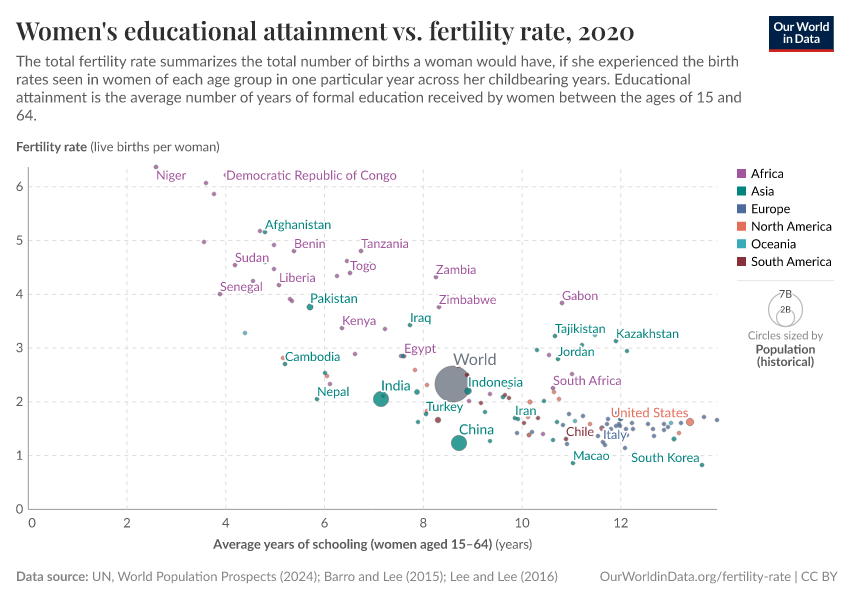Women's educational attainment vs. fertility rate
The total fertility rate summarizes the total number of births a woman would have, if she experienced the birth rates seen in women of each age group in oneparticular year across her childbearing years. Educational attainment is the average number of years of formal education received by women between the agesof 15 and 64.

Interactive visualization requires JavaScript
Related research and data
Charts
- Access to sexual and reproductive health care
- Adolescent birth rate, 10-14 year olds
- Adolescent birth rate, 15-19 year olds
- Age of mothers at childbirth by mother's birth yearMother's birth year
- Age of mothers at childbirth by year
- Annual birth rate and peak birth month
- Average age of mothers at childbirth
- Average age of mothers at childbirth by birth order
- Average age of mothers at childbirth by mother's birth year
- Birth rateLong-run
- Birth rateUN
- Birth rate by women's age group
- Birth seasonality
- Births per day, on a monthly basis
- Births per year, by world region
- Births, by age of mother
- Children per woman that survived childhood vs. those that died in childhood
- Completed cohort fertility rate: births per woman
- Contraceptive usage: modern methods vs. any methods
- Cumulative fertility rate by women's birth year
- Effective Fertility Rates, by age
- Female labor force participation rates vs. GDP per capita
- Fertility rate accounting for survival until childbearing ageMap
- Fertility rate accounting for survival until childbearing ageComparison
- Fertility rate accounting for survival until working age
- Fertility rate versus female labor force participation
- Fertility rate vs. GDP per capita
- Fertility rate vs. Human Development Index
- Fertility rate vs. average years of schooling
- Fertility rate vs. child mortality
- Fertility rate vs. share living in extreme poverty
- Fertility rate vs. share of women with no education
- Fertility rate vs. unmet need for contraception
- Fertility rate: births per womanUN
- Maternal mortality ratio vs. fertility rate
- Modern contraceptive prevalence vs. GDP per capita
- Number of live birthsHFD
- Peak birth month
- Peak birth month each year and birth rate per day
- Prevalence of modern contraception methods vs. women's educational attainment
- Projections of the fertility rate by education scenario
- Replacement-level fertility rate
- Share of births by age of mother
- Share of births registered
- Share of births that are twins
- Share of deliveries with single, twin or multiple children
- Share of women using contraceptives
- Share of women using modern contraceptive methods
- Share of women who have had a given number of births
- Share of women whose family planning needs are met
- Stillbirth rate
- The demographic transition in England and Wales
- Total fertility rate versus shifted cohort fertility rate
- Total fertility rate vs. contraceptive prevalence
- Total fertility rate vs. wanted fertility rateScatterplot
- Total fertility rate vs. wanted fertility rateLines
- Total fertility rate with projectionswith UN projections
- Total fertility rate: births per womanWorld Bank
- Total fertility rate: births per womanHFD
- Total fertility rate: births per womanLong-run
- Total number of births by birth order
- UN projection of infant deaths
- Unmet need for contraception among married women of reproductive age
- Wanted fertility rateLines